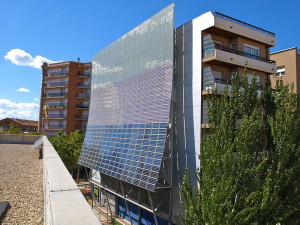By Staff
 Photovoltaic wall at MNACTEC Terrassa – courtesy wiki commons
Photovoltaic wall at MNACTEC Terrassa – courtesy wiki commons
This year’s CLEO Conference, sponsored by APS/Division of Laser Science, IEEE Photonics Society and the Optical Society includes S&I 15: LED, Photovoltaics and Energy-Efficient (“Green”) Photonics which is part of the Science & Innovations technical program. Tom Giallorenzi, OSA’s Science Advisor interviewed Jonathan Wierer, Sandia National Laboratories, USA, Photonics, Subcommittee Chair, S&I 15 to find out about some of the trends for this year’s hot paper submissions.
Tom Giallorenzi: Can you review the talks that you got and were there any themes or any outstanding trends that you were able to discern?
Jonathan Wierer: We have a tutorial by Seth Coe-Sullivan on colloidal quantum dots and then there were a few quantum dot submissions and one of them is by a student from Bilkent University.
He’s going to be talking about putting colloidal quantum dots into an LED structure. And the problem is the quantum dots are very small materials, and it’s not your typical planar PN junction where it’s very easy to make contacts and inject current and produce light. Now you have these small little quantum dots and the question is how do you put current into these quantum dots? So they’re putting these quantum dots into polymers that facilitates injecting current into them. And so that’s not necessarily new, but they’re trying to engineer the polymers to make that energy transfer from the polymers to the quantum dots more efficient.
Tom Giallorenzi: And did you get any papers on energy efficiency?
Jonathan Wierer: They’re all on energy efficiency. If I have an LED talk, nine times out of ten, they’re talking about making the LED more efficient. This quantum dot talk I was talking about from Bilkent University, the quantum dots are very efficient. So if I photo pump them, hit it with a laser and see how many photons I get out, that process is very efficient. What’s not efficient is trying to put it into an electrically injected structure. And so they’re trying to learn how to make that injection more efficient. And on the flip side, for example, this tutorial from Takashi Fukui, he’s trying to make nanowire solar cells more efficient. And if the solar cell is efficient, naturally your systems’ more efficient; you can harvest more of the sun.
Tom Giallorenzi: Could you characterize the energy program at CLEO this year?
Jonathan Wierer: So, for the energy efficiency CLEO programs, there’s two of them. The SI 15 is more on the device and device physics side and it covers LEDs and solar cells, but then we have a sister program going on that’s A&T 2 and there, they’re also concerned with energy and the environment, but it’s more at a system level. So you’ll see talks about LEDs, but at the system level, where they’re applying these sensors that are more energy efficient. So, it’s nice, you have these two sets of talks and they span the gamut from device physics up to the system level. So it gives you a nice broad cover of the energy sector.
Tom Giallorenzi: Why would somebody in the energy field want to come and hear some of these talks?
Jonathan Wierer: If you’re interested in solar, there’s a lot of strong talks covering enhanced absorption by using light trapping and plasmonic structures. And if you’re a researcher working in the solar field, that’s very interesting because it leads to a reduced amount of material that you have to use. And so there’s a lot of strong talks from students in the field that are up and coming and if I’m a solar guy at a solar company, not only do I want to find out if this information is useful for my company, but also I want to make connections with the students for the company’s future.
On the LED side, our invited talks play right into solid-state lighting. Using colloidal quantum dots for solid-state lighting and using nanowires for LEDs are hot topics. These talks are from two different companies. So they’re being implemented, and I think that’s probably really interesting for anybody in the LED field.
Tom Giallorenzi: When you say that we can implement it, are they in commercial products?
Jonathan Wierer: Yes, you can find some commercial products with colloidal quantum dots.
Tom Giallorenzi: And how much of a difference do they make?
Jonathan Wierer: So, for example, colloidal quantum dots can do things that conventional LEDs can’t. Seth Coe-Sullivan will talk a little bit more about it, but in the red, current LED technologies have some limitations. And the colloidal quantum dots may be able to help in the red; to reach efficiencies that you can’t get with conventional LEDs.
Tom Giallorenzi: What are some of the big reasons you think I should attend my CLEO?
Jonathan Wierer: One of the reasons why I like coming to CLEO is because there are always a lot of good excellent talks. CLEO has a very good reputation.
Not only is it a good way to see all these excellent talks, it’s also a way to meet these people face to face, to have interactions with them. That actually goes a long way for me personally. I have to make these connections and to try to build future research and programs, and maybe there’s common ground where we can work together. It’s just one of the reasons why I come here. Nine times out of ten, you can read what’s going on in the literature. I can sit at my desk, get on the computer, and read what these guys are doing. But actually coming to a conference, meeting the person, making a connection, it just takes it another step.
Tom Giallorenzi: Thank you very much.
For more information on the Science & Innovations program, visit www.cleoconference.org for more information.
Posted: 29 May 2013 by
Staff
| with 0 comments